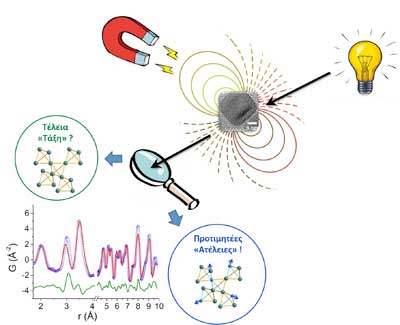| Jan 24, 2020 | |
How disorder in nanocrystals enables heat-therapeutic systems(Nanowerk News) A new research study at the Institute of Electronic Structure and Laser (IESL) of the Foundation for Research and Technology-Hellas (FORTH) finds that minute crystals, many thousand times smaller than a particle of dust, when they are dressed by the right kind of imperfections, adjust their electronic properties to favorably convert energy into heat, an important attribute for potential use in smart materials for energy, health, sensors etc. |
|
| The related article, co-authored by IESL’s Researchers, was published in Physical Review X ("Vacancy-driven Non-cubic Local Structure and Magnetic Anisotropy Tailoring in FexO-Fe3-δO4 Nanocrystals"). | |
| Along these lines and in particular in the battle to fight cancer, researchers are actively developing sophisticated strategies to destroy tumors by raising their temperature. In one such approach, nanoscale crystals (i.e. tiny particles, one-hundred thousand times smaller than the thickness of a human hair, called “nanocrystals”) injected into the cancerous tissue and heated by external stimuli (e.g. a magnetic field) offer a new, minimally invasive therapeutic solution that can also help to reduce toxicity of anticancer treatments. | |
| The team at IESL-FORTH (came up with the novel concept that the required physical properties can arise from the breaking of symmetries, such as by introducing vacancies (i.e. empty atomic sites), rather than by having crystals with perfectly ordered atomic arrangements. | |
 |
|
| Particles of light (photons) scattered by nanoscale crystals identify the distribution of atoms in their structure and recognize that the breaking of symmetries with defects favorably converts the energy of the crystals into heat. (Image: FORTH) | |
| The functionality of such a system’s state is reflected in improved performance when magnetically-mediated heating (local temperature increase beyond physiological limits, known as “hyperthermia”) is pursued with nanoscale crystalline particles. | |
| The idea endorses “Pierre Curie’s Principle” (1894), reasoning on the mysteries of symmetry breaking that influences wide-range phenomena in contemporary natural sciences (c.f. from piezoelectricity and quantum field theory to protein folding). | |
| To successfully conduct this critical research, Dr Alexandros Lappas, a chemical physicist and Research Director at IESL, has coordinated an inter-disciplinary collaboration that has brought together theory and modelling from INN-Demokritos(Greece), magnetic characterizations from CNR-SPIN & UNINA (Italy), scientific research with photons from CMPMSD-BNL (USA), and nanoscale materials analysis from LCN (UK) with the purpose to explore the relation of structural defects on the size and shape of iron-oxide, colloidal nanocrystals and determine how these couple to magnetic properties relevant to nanobiotechnology. | |
| Key to uncovering the present findings was the use of ultra-bright, high-energy particles of light (photons) offered at a synchrotron facility (NSLS-II, BNL, USA). Being hundreds of million times brighter than the conventional medical X-ray imaging sources, the extreme resolving power of such light beams, when scattered from a sample, helped to identify that metal atoms pulled out from the crystal lattice during a redox process, create vacant sites (i.e. imperfections) that are correlated to each other via local distortions. | |
| “The emerging local symmetry breaking due to defects, changes the nanocrystal’s magnetic anisotropy in the favorable direction. The vacancies act as pinning centers that foster the competition amongst the elementary magnets (spins) out of which they are composed, in effect impeding the coherent reversal and easy relaxation of the spins. This allows a remarkable ten-fold rise of the nanomaterial’s thermoresponsive performance, as compared to that obtained by defect-free entities. The release of energy from the spins, may resemble that of an object diffusing through a viscous medium, where the higher the density of the fluid, the more efficiently decelerates and its kinetic energy is converted into heat”, explains Alexandros Lappas, group leader at the Quantum Materials and Magnetism Lab of FORTH-IESL. | |
| The investigation suggests the broader implications of atomic-scale defect control as a design parameter thatfavors anisotropic properties for optimized nanomaterials, with simultaneous diagnostic and therapeutic functionalities (cf. magnetic image-guided thermoresponsive cellular processes, sought in the field of theranostics). |
| Source: Foundation for Research and Technology-Hellas | |
|
Subscribe to a free copy of one of our daily Nanowerk Newsletter Email Digests with a compilation of all of the day's news. |
